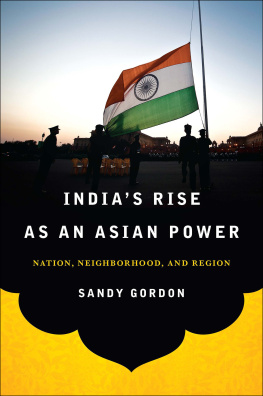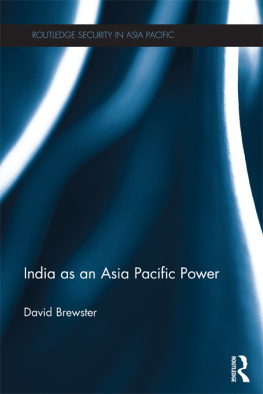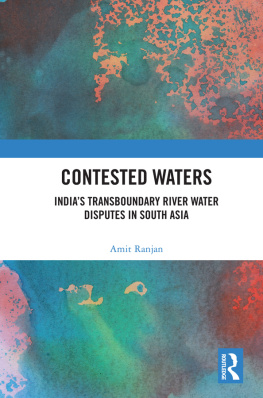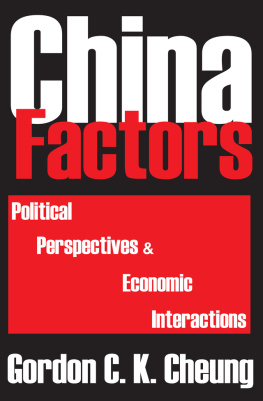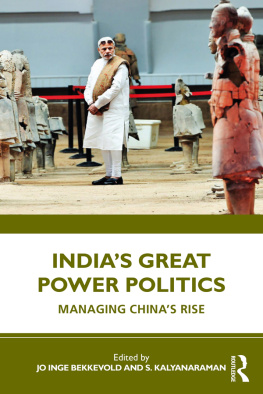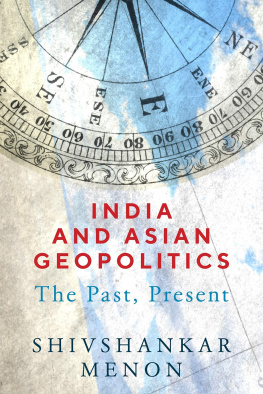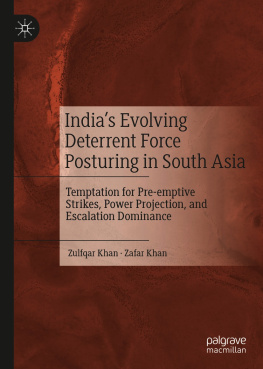INDIAS RISE
AS AN
ASIAN POWER
SOUTH ASIA IN WORLD AFFAIRS SERIES
T.V. Paul, Series Editor
EDITORIAL ADVISORY BOARD
Rajesh Basrur
Maya Chadda
Stephen P. Cohen
C. Christine Fair
Timothy Hoyt
Paul Kapur
Rajesh Rajagopalan
Aseema Sinha
TITLES IN THE SERIES
Afghan Endgames: Strategy and Policy Choices for Americas Longest War
Hy Rothstein and John Arquilla, editors
The Engagement of India: Strategies and Responses
Ian Hall, Editor
Globalization and Indias Economic Integration
Baldev Raj Nayar
Indias Rise as an Asian Power: Nation, Neighborhood, and Region
Sandy Gordon
Pakistans Counterterrorism Challenge
Moeed Yusuf, Editor
Vying for Allahs Vote: Understanding Islamic Parties,
Political Violence, and Extremism in Pakistan
Haroon K. Ullah
2014 Georgetown University Press. All rights reserved. No part of this book may be reproduced or utilized in any form or by any means, electronic or mechanical, including photocopying and recording, or by any information-storage-and-retrieval system, without permission in writing from the publisher.
Library of Congress Cataloging-in-Publication Data
Gordon, A. D. D.
Indias rise as an Asian power : nation, neighborhood, and region / Sandy Gordon.
pages cm. -- (South Asia in world affairs series)
Includes bibliographical references and index.
ISBN 978-1-62616-110-8 (hardcover : alk. paper) -- ISBN 978-1-62616-074-3 (pbk. : alk. paper)
1. India--Politics and government--21st century. 2. India--Economic conditions--21st century. 3. National security--India. 4. India--Foreign relations. 5. India--Foreign economic relations. 6. India--Foreign relations--South Asia. 7. South Asia--Foreign relations--India. I. Title.
DS449.G67 2014
327.54--dc23
2014000936

This book is printed on acid-free paper meeting the requirements of the American National Standard for Permanence in Paper for Printed Library Materials.
15 14 9 8 7 6 5 4 3 2 First printing
Printed in the United States of America
MANAN VATSYAYANA / AFP / Getty Images
PREFACE
This book has had a long gestation dating back to the beginning of the 1990s. At that time, I had an Australian government defense fellowship at the Australian National University (ANU). The outcome was Indias Rise to Power: In the Twentieth Century and Beyond (London: Macmillan, 1995). My thanks are due to Professor Desmond Ball of the ANU for inviting me to undertake that work.
In it, I sought to explain what I saw as Indias failure to rise rapidly to power given its megapopulation status. I did so in terms of the constraints India then confronted due to its sprawling domestic polity; difficult South Asian neighborhood; emerging environmental issues; flawed policies in education, defense industry, and technological acquisition; and limited progress with economic liberalization. I described India in this setting as acting according to a weak-strong paradigm. I concluded that even though India would likely become a declared nuclear power, its rise as an Asian and global power would be delayed till somewhat later in the twenty-first century.
Over a decade later I was kindly invited by Professor Peter Grabosky to take up a research position with the Centre of Excellence in Policing and Security (CEPS) at the Regulatory Institutions Network (RegNet), ANU. My thanks are due to Peter and my other colleagues at CEPS and RegNet, including Professor Roderic Broadhurst, who took over from Peter as head of CEPS on his retirement. My brief at RegNet was to cover governance, terrorism, and transnational crime. This focus reflected the fact that during the years between my first sojourn at ANU and my second, I had been, among other things, head of intelligence at the Australian Federal Police, equivalent to the Federal Bureau of Investigation in the United States.
On returning to ANU, however, I was still keen to revisit my work on India. I decided to do this by again looking at the issue of Indias rise to power, only this time with a greater emphasis on governance issues, especially corruption, terrorism, and crime. This work was furthered by a fellowship with the Institute for Defence Studies and Analysis (IDSA) in New Delhi in 2009. My thanks are due to the then director and colleagues at IDSA for the assistance they provided and the fruitful discussions I had. I also received help from several members of the Central Bureau of Investigation and National Investigation Agency. My thanks to them as well.
My renewed interest in India predated the global financial crisis (GFC) in 2008. At that time, India was widely perceived as a rapidly emerging power and a potential swing state in the Asia-Pacific strategic context. This was due to the fact that economic growth had shown remarkable progress since liberalization was first commenced in 1991, with growth persistently in the range of 7 percent to 9 percent. With the lingering GFC and other bottlenecks, however, growth has recently fallen to just over 5 percent. At the same time, there has been an escalation in so-called megacorruptionor at least that has been the public perception. Confidence in India and its imminent rise to power has somewhat diminished as a consequence. Concern about governance and corruption and their role in retarding Indias growth is in the air, so to speak. In that sense, I hope this book is timely and useful.
In order to be so, it seeks not just to be analytical but also prescriptive, especially in its final two chapters. I am highly conscious that, as a non-Indian, I am entering potentially difficult terrain in offering prescriptions to those who actually run India and are far better informed than myself about the problems and constraints that confront them. I am also conscious that in prescribing strategies for India, I am prescribing them not for a country, which cannot, of course, make and carry out policy, but rather for a vast array of policymakers right across India.
I put forward two points by way of explanation. First, the so-called strategies prescribed here are only meant to be heuristic. They are strategies that might sensibly be prescribed (or so I believe) were there such a single policy entity as India capable of carrying them out. In that sense they are an intellectual exercise to see what might be done given the analysis carried out in the first four chapters of the book and given Voltaires best of all possible worlds.
Second, my hope is that by prescribing strategies, I can contribute to a discussion of what Indias broad priorities should be. In saying that, I am not naive enough to suppose that policymakers in India will necessarily have the time or inclination to read this book. But hopefully some others may, and it may therefore enter the debate of ideas that usually precedes significant change.
As well as the people named above, I would like to thank those associated with the South Asia project at Georgetown University Press, especially Professor T. V. Paul, Don Jacobs, and Deborah Weiner who have been unfailingly courteous and helpful.

 This book is printed on acid-free paper meeting the requirements of the American National Standard for Permanence in Paper for Printed Library Materials.
This book is printed on acid-free paper meeting the requirements of the American National Standard for Permanence in Paper for Printed Library Materials.
